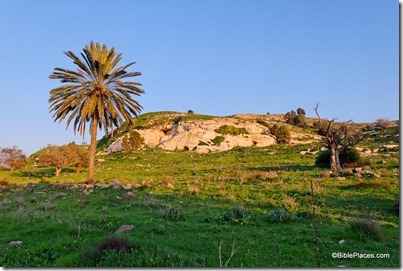Has the family tomb of the Maccabees been discovered? An Israeli archaeologist who studied a site near Modi’in answers positively. The report in Hadashot Arkheologiyot is rather long and somewhat technical. I have selected some of the more interesting sections.
Horbat Ha-Gardi – one of the sites identified with the Tomb of the Maccabees – is located c. 3 km northwest of the town of Modi‘in (Fig. 1), next to the settlement of Mevo Modi‘in and alongside a dirt track (the patrol road) leading north. The site looks out to the west toward the Shephelah and the Mediterranean Sea; to the east is Nahal Modi‘in, on whose eastern bank, opposite the ruin, the village of El-Midya is located.
[…]
The ruin consists of two sites (Fig. 2): the tomb of Sheikh Gharbawi (Fig. 3) and 18 m to the north, the remains of a magnificent structure (below), which the local villagers refer to as al-Qala‘a (the fortress). Horbat Ha-Gardi is the northern of three ruins; the other two being Khirbat Hammam and Kabur el-Yahud (Tombs of the Jews), which extend across the ridge that borders Nahal Modi‘in on the west (see Fig. 1).
[…]
The myth of the Maccabees, identifying ancient Modi‘in – the seat of the Maccabees, the place where the revolt against the Greeks broke out in 167 BCE and especially the family tomb where they were interred – attracted the first scholars of the Land of Israel to the region in the nineteenth century. What they had in mind was the tomb, described in detail in I Maccabees (13:27–30) and in the writings of the Jewish historian Josephus of the first century CE, in Antiquities of the Jews (XIII, 211–213). The church fathers Eusebius and Hieronymus also describe Modi‘in and the tomb monument. The tomb also appears on the Madaba Map of the sixth century CE. We know from historical sources that Modi‘in was situated close to Lod (Diospolis), on the main road leading from the Shephelah up to Jerusalem.
[…]
Clermont-Ganneau did not rule out the possibly that unequivocal evidence will be found in the future, indicating that the site is the burial place of the Maccabees. He also added that “this structure was probably built by the Christians to commemorate the burial place of the holy Maccabees.”
Lieutenant Claude Reignier Conder visited the site in 1873 on behalf of the Palestine Exploration Society. He was impressed with the structure and declared that he had never seen a building identical to this in his explorations around the country (C.R. Conder 1873. Jerusalem and El Midyeh. PEQ 5:94). He returned to the site in 1874, accompanied by Charles Tyrwhitt Drake, an English scholar who was also a member of the British research expedition. Drake, who sketched a reconstruction of the tombs, stated decisively, “In my opinion there is no doubt that these are the tombs of the Maccabees” (T. Drake 1874. Mr. Tyrwhitt Drake’s Report. PEQ 6:78).
[…]
It should be noted that modern scholars tend to identify Horbat Ha-Gardi with the family burial compound of the Maccabees, or at least with the spot where the grave was marked in the Byzantine period; however, this determination is a wishful thinking, based on circumstantial evidence rather than on clear archaeological findings.
[…]
The task of the current expedition was to relocate the structure, which was exposed by the nineteenth-century scholars and inspect its remains. The illustrations and maps prepared by Guérin and Clermont-Ganneau aided in locating the magnificent structure relative to the sheikh’s tomb and the eastern burial chamber inside it (No. 1).
[…]
The nature of the structure and its dating are still unclear. Although the test was superficial and limited and did not include a proper archaeological excavation, methodological assumptions, some of which had already been raised in the past, can be introduced, based on the test and an analysis of the findings.
1. The dimensions of the structure are much larger than those revealed by the nineteenth-century scholars; they include additional sections that extend across an area of 6 dunams, although it is not yet clear if these sections belong to one complex or to a single period.
2. The quality of the construction and the size of the funerary structure are uncommon in ancient architecture and are unparalleled in the tombs known at Modi‘in and its vicinity, testifying to its importance….The remains can evince a tomb of magnificent splendor, built according to the best Jewish tradition, i.e., a rock-hewn tomb, a patrimony in which changes were made over the course of generations.
[…]
8. The size of the site, its plan, location, the nature of its construction and the architectural elements incorporated in it, are consistent with the descriptions of the tomb that appear in the Book of Maccabees and in Josephus.
The circumstantial archaeological evidence underlines the possibility of identifying Horbat Ha-Gardi with the family tomb of the Maccabees, or at least with the marking of the tomb in the Byzantine period. A proper and systematic archaeological excavation of the site will provide answers that either confirm or refute the identification of the site.
